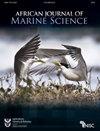非洲南部西海岸深水黑鲈幼鱼的饮食和生存状况
IF 1.4
4区 生物学
Q3 MARINE & FRESHWATER BIOLOGY
引用次数: 0
摘要
描述并比较了三种身体状况组(低于平均水平、平均水平和高于平均水平)的深水黑鲈幼鱼的饮食组成。饮食分析采用三个指标:发生率,数值和重量。2012年1月和2月,在非洲南部西海岸的Orange Banks和Hondeklip Bay之间,Dr Fridtjof Nansen号在水深30-232米的地方部署了28个拖网,捕获了鳕鱼幼鱼。所分析的300条鱼是捕获的所有幼鱼(3114条)的代表性样本,长度从52到205毫米不等(平均长度为107毫米)。它们的食物包括:光鳞鳞鱼、双足类鱼、口足类鱼、中远洋鱼(Maurolicus muelleri)和海鳞鳞鱼(lamanyctodes hectoris)。在身体状况组之间,饮食的唯一显著差异是在数值指标上,双足类和杂交片脚类。试验了一种利用耳石重量评价鱼体状况的新方法。由于数据变异性大,样本量小,该方法不能有效应用于本研究。然而,当可变性可以降低时,耳石重量有可能作为一种新的鱼况指标。本文章由计算机程序翻译,如有差异,请以英文原文为准。
Diet and condition of juvenile deep-water hake Merluccius paradoxus on the west coast of southern Africa
The composition of the diet of juvenile deep-water hake Merluccius paradoxus is described and compared for three body-condition groups (below-average, average, and above-average). Diet was analysed using three metrics: occurrence, numeric and gravimetric. Juvenile hakes were caught in January and February of 2012 by means of 28 trawl deployments from the RV Dr Fridtjof Nansen between Orange Banks and Hondeklip Bay on the west coast of southern Africa at depths of 30-232 m. The 300 individuals analysed were a representative sample of all juveniles caught (3 114 fish), ranging in length from 52 to 205 mm (average length 107 mm). Their diet consisted of the euphausiid Euphausia lucens, the hyperiid amphipod Themisto gaudichaudii, the stomatopod Pterygosquilla armata capensis, and mesopelagic fishes Maurolicus muelleri and Lampanyctodes hectoris. The only significant difference in diet between the body-condition groups was for euphausiids and hyperiid amphipods in the numeric metric. A new method of assessing fish condition using otolith weight was tested. Because of the large variability in the data and small sample size, this method could not be applied effectively in this study. However, otolith weight has potential as a new fish condition metric when the variability can be lowered.
求助全文
通过发布文献求助,成功后即可免费获取论文全文。
去求助
来源期刊

African Journal of Marine Science
生物-海洋与淡水生物学
CiteScore
2.60
自引率
16.70%
发文量
17
审稿时长
6-12 weeks
期刊介绍:
The African (formerly South African) Journal of Marine Science provides an international forum for the publication of original scientific contributions or critical reviews, involving oceanic, shelf or estuarine waters, inclusive of oceanography, studies of organisms and their habitats, and aquaculture. Papers on the conservation and management of living resources, relevant social science and governance, or new techniques, are all welcomed, as are those that integrate different disciplines. Priority will be given to rigorous, question-driven research, rather than descriptive research. Contributions from African waters, including the Southern Ocean, are particularly encouraged, although not to the exclusion of those from elsewhere that have relevance to the African context. Submissions may take the form of a paper or a short communication. The journal aims to achieve a balanced representation of subject areas but also publishes proceedings of symposia in dedicated issues, as well as guest-edited suites on thematic topics in regular issues.
 求助内容:
求助内容: 应助结果提醒方式:
应助结果提醒方式:


